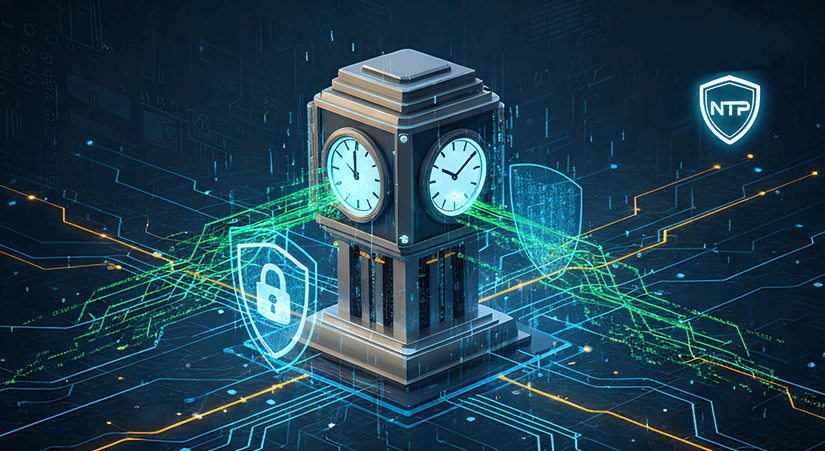Network Time Protocol Hardening for Tamper-Resistant Clocks
Network Time Protocol (NTP) is fundamental to digital infrastructure, ensuring accurate clock synchronization across computer networks and devices. NTP enables precise coordination for server operations, authentication protocols, transaction sequencing, and log integrity. However, the protocol’s original design prioritized accuracy and scalability over security, which now leaves modern environments exposed to increasingly sophisticated threats. As organizations expand with distributed systems, cloud adoption, and stricter compliance requirements, hardening NTP and related protocols like Precision Time Protocol (PTP) is crucial for operational resilience, compliance, and maintaining digital trust.
Understanding NTP’s Role in Security and Operations
NTP synchronizes clocks by referencing external time sources, commonly stratum 1 servers connected to atomic clocks or GPS. This synchronization is foundational for authentication mechanisms such as Kerberos, digital certificate validation, and accurate log correlation across distributed systems. Inaccurate or manipulated clocks can lead to failed authentication, missed compliance objectives, unreliable forensics, and undetected attacks.
Risks and Vulnerabilities in NTP and PTP
The open, stateless nature of traditional NTP exposes organizations to several attack vectors:
- Spoofing & Man-in-the-Middle Attacks: Threat actors may impersonate time servers or intercept NTP traffic, injecting misleading time data to disrupt authentication or conceal malicious activity.
- Denial-of-Service & Amplification: Public NTP servers are vulnerable to exploitation in DDoS attacks or can themselves be overloaded, causing network-wide desynchronization.
- Packet Manipulation & Delay: Attackers may introduce or delay NTP packets, resulting in subtle but impactful clock drift that undermines system reliability and trust.
- Internal Compromises: Insider threats or compromised internal devices can inject false time data or disrupt synchronization, bypassing external safeguards.
- Cryptographic Weaknesses: Legacy authentication schemes such as MD5, or weak key management, create vulnerabilities that can be exploited in targeted attacks.
PTP, widely used in sectors demanding nanosecond or microsecond precision—including finance, telecommunications, and industrial automation—faces similar challenges. Its reliance on specialized hardware and critical infrastructure increases the potential impact of attacks.
Foundational Principles for Tamper-Resistant NTP Hardening
Securing time synchronization requires a comprehensive, layered approach:
- Access Control & Segmentation: Limit NTP server access strictly to authorized network segments and trusted IP addresses. Firewalls and internal controls should enforce this policy.
- Minimize Attack Surface: Disable unused NTP commands, queries, and broadcast features, as these can be leveraged for attacks if left enabled.
- Authenticated, Reliable Time Sources: Use cryptographic authentication for all time exchanges. For larger or public-facing deployments, implement Network Time Security (NTS) for TLS-based authentication.
- Redundancy & Byzantine Tolerance: Configure clients to query multiple, independent time sources from different providers and regions, enabling them to ignore outliers and resist single-point compromise.
- Continuous Monitoring & Anomaly Detection: Use monitoring tools to track offset, jitter, and synchronization health. Automated alerts should be in place for significant drift or suspicious trends.
- Regular Updates & Auditing: Keep NTP software and system packages up to date. Routinely audit configurations to eliminate unnecessary permissions and outdated settings.
- PTP Isolation & Verification: In high-precision environments, operate PTP on isolated networks and enable protocol-level authentication and monitoring.
Step-by-Step Guidance for Hardening Clocks
- Restrict Access: Allow only trusted segments to communicate with your NTP servers using both firewall rules and application-level controls.
- Disable Non-Essential Features: Turn off unnecessary monitoring commands and broadcast modes that could be misused for reconnaissance or attacks.
- Authenticate Every Source: Apply cryptographic or NTS-based authentication to all NTP communications, with robust key management and scheduled rotations.
- Keep Software Updated: Regularly patch NTP daemons and underlying operating systems to address new vulnerabilities and security advisories.
- Deploy Redundant Sources: Configure clients to consult several independent NTP servers, ideally from different operators and regions, to ensure resilience.
- Monitor & Audit Continuously: Use monitoring solutions to track synchronization health and trigger alerts on anomalies or suspicious patterns.
- Harden PTP Deployments: Use isolated network segments and protocol authentication for environments requiring microsecond precision.
- Document & Train: Maintain comprehensive documentation of synchronization policies and train staff to recognize and respond to time-based threats.
Best Practices for Ongoing Secure Deployment
- Rotate cryptographic keys regularly and after personnel changes.
- Use centralized management for consistent server configurations.
- Test failover and recovery procedures to confirm resilience.
- Align with regulatory frameworks such as PCI DSS, NIST, and HIPAA.
- Utilize hardware security modules (HSMs) where available for secure key storage.
Dataplugs: Building a Foundation for Secure Time Synchronization
The security and reliability of your NTP or PTP deployment depend on the quality of your supporting infrastructure. Dataplugs delivers a robust platform with:
- Enterprise-Grade Hardware: Reliable, low-drift servers minimize the risk of hardware failures.
- Redundant Global Network: Multi-provider BGP connectivity ensures low latency, minimal jitter, and high availability for all time-sensitive traffic.
- Integrated Security: Advanced DDoS protection and firewalls safeguard NTP and PTP services from direct and amplification attacks.
- Expert Support: 24/7 technical assistance for configuration, monitoring, and incident response.
- Compliance-Ready Infrastructure: Built to support audit and regulatory requirements for timekeeping and operational transparency.
With Dataplugs, organizations can confidently deploy hardened, tamper-resistant time synchronization for both standard and high-precision environments, supporting continuous operations and digital trust.
Conclusion
Securing network time protocols is foundational to operational integrity, regulatory compliance, and effective incident response. By hardening NTP and PTP, implementing multi-layered defenses, and maintaining vigilant monitoring, organizations build tamper-resistant clock synchronization and a trustworthy foundation for all digital transactions. Leveraging secure infrastructure and expert support from Dataplugs further protects against time-based threats and ensures every record and action is anchored in accuracy.
For tailored advice or to discuss your secure time synchronization requirements, contact Dataplugs via live chat or email sales@dataplugs.com. Our team is ready to help you strengthen your timekeeping and overall security posture.
